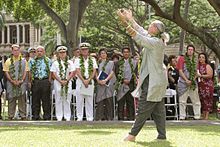
Back Hula Afrikaans هولا Arabic Танец хула Byelorussian Hula (Tanz) German Hula danco Esperanto Hula (danza) Spanish رقص هولا Persian Hula Finnish Hula Fiji Hula French


Hula (/ˈhuːlə/) is a Hawaiian dance form expressing chant (oli)[1] or song (mele). It was developed in the Hawaiian Islands by the Native Hawaiians who settled there. The hula dramatizes or portrays the words of the oli or mele in a visual dance form.
There are many sub-styles of hula, with the two main categories being Hula ʻAuana and Hula Kahiko.[2] Ancient hula, performed before Western encounters with Hawaiʻi, is called kahiko. It is accompanied by chant and traditional instruments. Hula, as it evolved under Western influence in the 19th and 20th centuries, is called ʻauana (a word that means "to wander" or "drift"). It is accompanied by song and Western-influenced musical instruments such as the guitar, the ʻukulele, and the double bass.
Terminology for two additional categories is beginning to enter the hula lexicon: "Monarchy" includes any hula which were composed and choreographed during the 19th century. During that time the influx of Western culture created significant changes in the formal Hawaiian arts, including hula. "Ai Kahiko", meaning "in the ancient style" are those hula written in the 20th and 21st centuries that follow the stylistic protocols of the ancient hula kahiko.
There are also two main positions of a hula dance: either sitting (noho dance) or standing (luna dance). Some dances utilize both forms.

Hula dancing is complex, with many hand motions used to represent the words in a song or chant. For example, hand movements can signify aspects of nature, such as the swaying of a tree in the breeze or a wave in the ocean, or a feeling or emotion, such as fondness or yearning. Foot and hip movements often pull from a basic library of steps including the kāholo, kaʻo, kāwelu, hela, ʻuwehe, and ʻami.
There are other related dances (tamure, hura, 'aparima, 'ote'a, haka, kapa haka, poi, Fa'ataupati, Tau'olunga, and Lakalaka) that come from other Polynesian islands such as Tahiti, The Cook Islands, Samoa, Tonga and New Zealand; however, the hula is unique to the Hawaiian Islands.[3]
Five hula genres can be placed across a spectrum with "the most ancient" on the left and "the most modern" on the right side. The Hula pahu and hula 'āla'apapa subcategories are ancient, originating before the introduction of Christianity. Thanks to well-preserved documentation, guidelines for performers to bring the poetic text back on stage remain clear in manuscript sources. On the other side of the continuum, hapa haole songs are relatively modern and they were also disseminated as notated sheet music, the joint effort of contemporary ethnomusicologists and songwriters. The other the two hula types, hula ku'i and hula 'ōlapa are a challenge to editors in terms of textualizing and representing them within a critical edition. These two genres reflect the social transformation and westernization within the region, influenced by American economics and politics. More importantly, the same strophic text format is applied in both genres, constructed with two or four lines of text, with each of them commonly set to a uniform number of beats. During performance, it is a usual practice that the songs are separated into stanzas which are repeated by a brief rhythmic interlude. Among the genres of hula, the corresponding melodic structure and the strophic musical structure make modern hula ku'i and hula 'ōlapa distinguishable from the others.[4]
- ^ chants which are called oli are usually not danced to; cf. Mary Kawena Pukui; Samuel Hoyt Elbert (2003). "lookup of oli". in Hawaiian Dictionary. Ulukau, the Hawaiian Electronic Library, University of Hawaii Press.
- ^ "A Brief History of the Hula". Hawaii Ocean project. February 1, 2018. Retrieved January 12, 2021.
- ^ Leilani Holmes, Ancestry of Experience: A Journey into Hawaiian Ways of Knowing (Honolulu: University of Hawai'i Press, 2012), 6.
- ^ Stillman, Amy Ku'uleialoha (2005). "Textualizing Hawaiian Music". American Music. 23 (1): 69–94. doi:10.2307/4153041. ISSN 0734-4392. JSTOR 4153041.
© MMXXIII Rich X Search. We shall prevail. All rights reserved. Rich X Search